





Together, Ohio Girl Scout Councils gathered hard-hitting data and statistics to evaluate the state of girls. This report of our findings will help us, and the entire community, better understand girls, so we can ignite change.
We had heard from girls and families that girls are struggling and the research in this report confirms it. What we found is that girls today face significant challenges that affect their ability to thrive physically, socially, mentally, and academically.
Girl Scouts has 113 years of experience in meeting girls’ needs. Our national programming is designed to develop healthy relationships, strong sense of self, and positive values. We are committed to ensuring all girls, regardless of socioeconomic background, race, or ability, have access to opportunities to succeed. But Ohio’s girls need more. They need more advocates, more mentors, and more opportunities that help them build confidence and skills for the future.
Our goal in creating this report is to serve as a credible source of data in our communities that will generate new efforts, actions, and investments to improve the lives of girls in our state. The more we understand their needs, the better equipped we will be to advocate for them and create meaningful, lasting change.
Today’s girls are resilient but face many challenges. In this report, you’ll find key insights we’ve learned about the state of girls in Ohio, as well as potential ways that our communities can step up to ensure that Ohio’s girls recognize their worth, value their unique abilities, and have the tools they need to lead fulfilling lives.
Girls deserve better. Join us in building a future where all girls have the opportunity to be their best selves.

Beth Casey



Jane Christyson Tammy Wharton Aimée Sproles



Real life is never simple. Girls’ lives are compl and messy but Ohio girls are also resilie
Girls face serious challenges.
56%

of Ohio girls in grades 9-12 reported feeling sad or hopeless, 32% seriously considered attempting suicide in 2021 and 15% reported a suicide attempt in 2021.
39%
of Ohio middle school girls and 28% of high school girls were bullied online in 2021. Bullying and cyber-bullying negatively impacts girls’ emotional well-being
27%
of girls were chronically absent from school in 2022-23, and the percent of girls proficient in math, science, and English Language Arts decreased between 5th and 8th grades.
18%
of Ohio girls in grades 9-12 reported experiencing sexual dating violence in 2021, increasing by 64% between 2019 and 2021. Sexual dating violence puts girls’ physical safety at risk.
Right now is a hard time in society, especially for girls and young girls at that. [Girls] want to feel wanted and not left out... They want to feel loved, wanted, and seen.
In 2023, being a Gen Z girl means navigating a world of unprecedented change, challenges, and opportunities.
- Kennedy, Girl Scout of Ohio’s Heartland Alum

Girls are resilient.
95%
of girls ages 6-18 had health insurance. In addition, Ohio teen birth rates decreased steadily between 2013 and 2022.
91%
of girls graduated from high school in 2022-23, a higher rate than boys. Girls also enrolled in higher education at a higher rate than boys.
More 25 to 39 year old women in Ohio reported they attained a STEM or STEM-related bachelor’s degree than in past years.
48%
of girls participated in clubs or organizations, a higher rate than boys in 2021-22, and 55% of girls participated in sports, in 2021-22 a similar rate to boys.
In addition to the health and developmental benefits of social engagement, a meta-analysis of studies examining organized activities found positive connections between organized activities and involved youth’s moral and civic development.
Organized activities encompass a wide range of possible involvements for girls, including clubs and activities like 4-H, Girls Who Code, FFA, and Girl Scouts They also include sports and unofficially recognized clubs like chess, art, or theater.
Girl Scouts needs us. It takes all of us to be able to support girls to be who they are in life and paving the way. Girl Scouts paved the way for me.
– Jen R , OhioHealth, Girl Scout Supporter
This [Girl Scouts] is a place where you can affect young people’s lives, give girls the opportunities they might not otherwise have, to become leaders, to invest in them, to help them learn skills.
- Jim M , DHL and GSOH Board Member
Learn more about this project, our data sources, or Ohio girl data specific to your county
Girl Scouts in Ohio believe that caregivers, youth program providers, state policy makers, and schools can work together to reduce these challenges and to build girls’ resiliency, to positively impact girls’ overall wellness.
Together, we need to:
Increase girls’ access to positive, challenging activities and supportive adults, to build girls’ selfconfidence and resilience at every stage of development.
Address interpersonal aggression, including cyberbullying and dating violence, through prevention and support, to reduce its occurrence and the long-term impact on girls’ mental health.
Provide access to mental health resources, including through programs, interventions and licensed mental health services.
Girls’ capacity to thrive increases when they have safe spaces to grow emotionally and physically, when they are surrounded by supportive adults, when they are introduced to new experiences that help them develop new skills, and when they stay physically active and socially connected. We have the ability to increase girls’ access to these conditions.
Listen & Learn Encourage & Explore Create Community Caregivers
You are the first and most important caring adult in your girls’ lives.
Engage in active listening daily with your girl so that she trusts that you are a safe place for her to share her reality. Display curiosity and support for the challenges she faces each day Seek resources to help her develop resilience
Help your girl to explore and discover her interests and strengths Encourage her to overcome academic challenges and help her discover the new skills she can develop through persistence. Join her in researching potential career opportunities that align to her unique strengths.
Girls thrive when they have relationships with caring adults who support them. Connect your girl with community organizations and caring adult mentors that help her develop her unique gifts. Join a Girl Scout troop with your daughter so you can join her as she explores interests, learns to address community problems and develops friendships

Girls thrive when they have access to experiential learning, healthy relationships, team-based challenges and opportunities to take risks in a safe environment.
There are unique differences in the lived experiences and learning needs of girls and boys. Provide boys and girls with relational aggression prevention programming to stem the tide of physical and cyber bullying and dating violence
Provide program staff access to resources and professional development to support today’s girls. Provide mental health and trauma-informed training to adapt program delivery to the needs of participants
The systems across Ohio impact the lived experiences of the girls in our communities, and you play a critical role in creating a better future for girls.
Provide Resources Collaborate in Education
Support Safe Communities Schools
Fund mental health resources and provide access to programming that supports girls’ resilience. Address youth online safety to increase development of positive social networks and decrease cyberbullying.
Enable schools to collaborate with evidence-based program providers that contribute to academic achievement, social emotional learning and career exploration to prepare girls for the jobs of Ohio’s future workforce.
Fund and provide access to in-school and after-school programming, including on school campuses, that contribute to increased attendance, healthy relationships, experiential learning and youth leadership development.
Parents tell us that they need access to additional resources for their youth, and that schools are the center of community where they seek that support. We know that a lot is already asked of our schools. Below are potential focus areas that you may already be developing
Girls for the Future
Develop Faculty & Staff
Enforce Policies
Collaborate
Assess and target the gaps in meeting student needs and challenges to girls’ successful progression from 3rd through 8th grade Build the academic foundation to prepare girls for the jobs of the future Teach digital literacy, personal safety online and cybersecurity
Provide professional development in trauma-informed mental health and social emotional learning to ensure teachers and staff have the skills to meet girls’ mental health and academic needs.
Ensure staff and faculty have the awareness and support they need to consistently enforce school harassment, bullying and violence prevention policies
Team with evidence-based programs to further achievement in social-emotional learning standards that cultivate a positive school culture. Partner in experiential learning that expands girls’ access to new topics and skills and improves academic achievement.

Girls under 18 in Ohio, have grown increasingly diverse, mirroring national trends. Poverty rates for women have increased, but for Ohio households with girls under 18, the poverty rate has remained flat. Health insurance rates are high for girls, with under 5% having no insurance and 36% having public health insurance.
Demographic data are provided by the U S Census, which uses the following definitions:
Race: The racial categories included in the census questionnaire generally reflect a social definition of race recognized in this country and not an attempt to define race biologically, anthropologically, or genetically. In addition, it is recognized that the categories of the race item include racial and national origin or sociocultural groups.
Sex: The determination of male/female population based on biological attributes such as chromosomes, anatomy, hormones, etc.
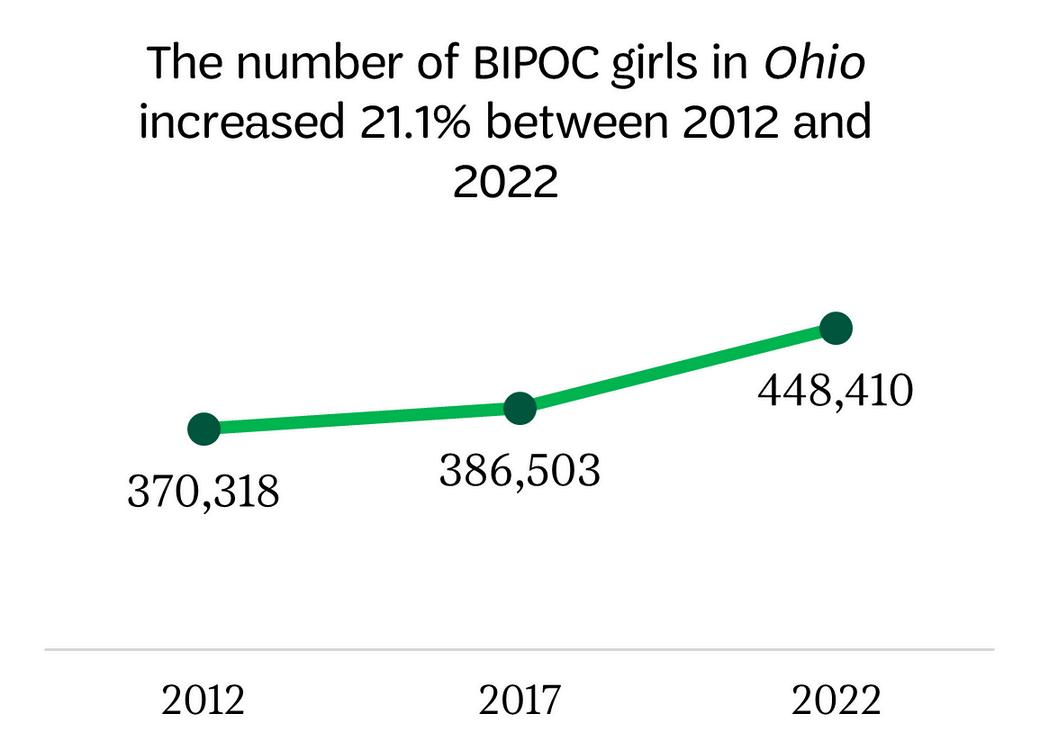
Ohio girls by race and ethnicity, in 2022
NOTE: The number of Ohio females and males in each demographic category is similar and therefore not provided

The population of Ohio females under 18 has grown increasingly diverse at about the same rate as the national average.

The national poverty rate is currently higher than before the COVID-19 pandemic In general, U S females of all ages report higher poverty rates than males Poverty rates for Ohio girls have remained steady since 2012.

More than 1.2 million Ohio females between the ages of 6-18 were covered by health insurance in 2022, but 61,956 girls had no coverage.
Health insurance coverage in childhood increases the likelihood of children: becoming healthy adults, having stable employment, and receiving less public assistance
1 in 5 2
Ohio girls went to the emergency room at least once in 2022, which was slightly less than 21% of boys.

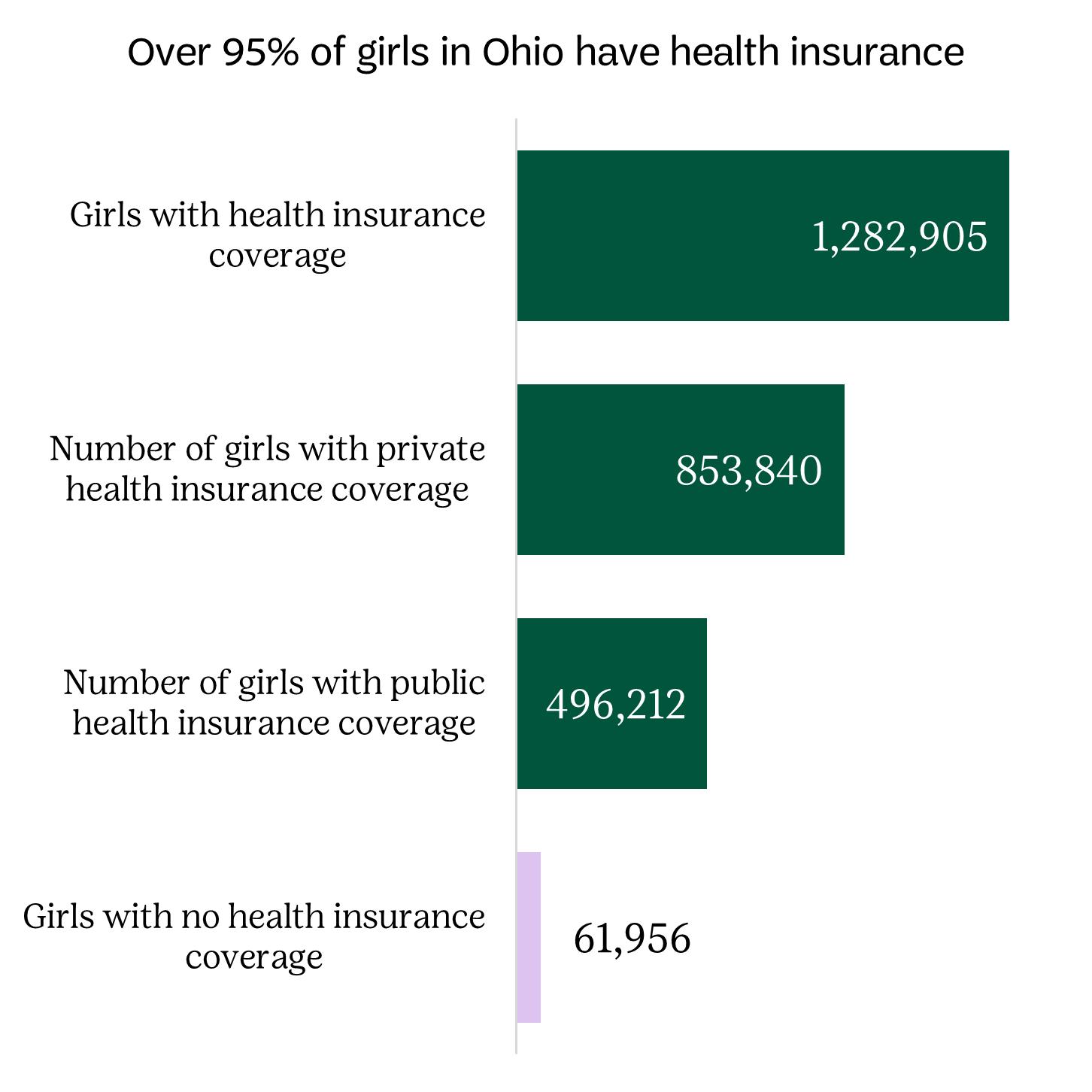
Girls face challenges to their physical wellbeing. Only 16% of Ohio girls participate in recommended levels of physical activity. Even more concerning, levels of sexual dating violence have substantially increased for Ohio girls. More positively, Ohio teen birth rates continue to fall.
The World Health Organization advises that children aged 5 to 17 engage in at least 60 minutes of physical activity each day Activities can include play, games, and organized exercise such as after-school sports and physical education classes.
Research highlights that increased variety and duration of exercise is linked to numerous health benefits: reduced risk of depression enhanced academic performance support for a healthy weight
However, only 16% of Ohio girls meet this threshold through exercise, playing a sport, or participating in a physical activity, compared with 25% of boys.
Despite participating in more exercise, boys have somewhat similar body-mass index rates (BMI) to girls. Only 59% of girls have a healthy weight, with 6% underweight and 35% either overweight or obese. In comparison, 55% of boys have a healthy weight, with 7% underweight, and 38% either overweight or obese

What is the best thing you did in Girl Scouts this year and what made it so special for you?

Ohio girls in grades 9-12 who reported experiencing sexual dating violence at the hands of a partner, increased in 2021 to 18%. Rates of physical dating violence, which is defined as being physically hurt on purpose by someone they were dating have decreased since 2013. 4
A 2020 meta-analysis indicated that the risk factors for teen dating violence include:
substance use
risky sexual behaviors
suicide attempts
eating disorders
If you are experiencing relationship violence, call the Hotline at 1-866331-9474 or text “LOVEIS” to 22522 Services are available 24/7/365

National teen birth rates peaked in 1991 with a birth rate of 61.8 births per 1,000 girls aged 15 to 19. Although slightly higher than national average, teen birth rates have declined dramatically in Ohio and nationally since 2013.
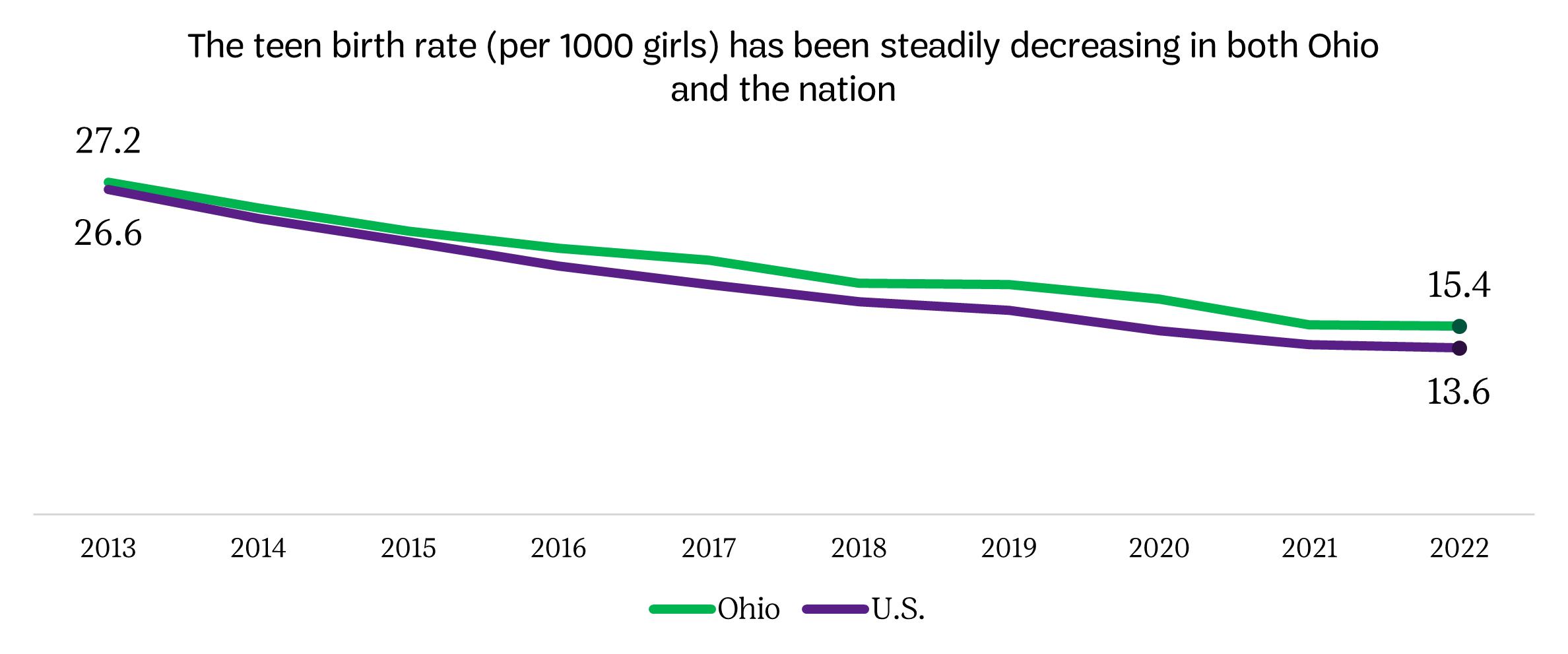

Ohio girls face a range of adverse childhood experiences (ACEs) associated with negative physical and mental health outcomes. More than half of high school girls reported feeling sad or hopeless, while nearly 40% of girls in need of services reported some level of difficulty accessing mental health treatment. In addition, only 54% of Ohio children reported having a caring adult who they can talk to about their feelings all or most of the time.
Adverse Childhood Experiences (ACEs) refers to adversities many children experience before the age of 18. Research shows that as the number of ACEs increases, so does the risk of various negative medical and mental health outcomes in adulthood In Ohio, boys and girls experience similar percentages of ACEs, with one-fifth of the children reporting at least one adverse childhood experience.
When Ohio caregivers were asked about their children’s experiences, 13% of households with girls indicated they had struggled somewhat often or very often to cover the basics like food or housing, while 57% of families reported they never struggled and 30% rarely struggled during the child’s lifetime
Ohio caregivers reported girls in their household had faced other adverse childhood experiences, with 21% of girls experiencing parent or guardian divorce or separation
Adverse Childhood Experiences reported by caregivers of girls in Ohio, in 2021-2022
Parent or guardian divorced or separated
Hard to cover the basics, like food or housing, on family’s income
Lived with anyone who was mentally ill, suicidal, or severely depressed
Parent or guardian served time in jail
Witnessed domestic violence
Victim or witness of neighborhood violence Treated
Parent or guardian died
Treated or judged unfairly because of health condition or disability
Treated or judged unfairly because of sexual orientation or gender identity

According to the U.S Surgeon General’s 2023 Advisory on the Healing Effects of Social Connection and Community, adults in the United States are experiencing a public health crisis of loneliness, isolation and a lack of connection. The loneliness crisis predates the COVID-19 pandemic and may increase the risk for developing mental health challenges and an increase in premature deaths at levels comparable to daily smoking.
According to mental health practitioners, the number of people who are seeking help for stressrelated disorders such as anxiety and trauma has increased since the onset of the COVID-19 pandemic. Unfortunately, children under 18 are also experiencing increases in the prevalence of mental health challenges. 5
6 7
of Ohio girls in grades 9-12 reported feeling sad or hopeless, in 2021. 56%
In 2022, 31% of Ohio girls had difficulty in obtaining mental health treatment or counseling, and 8% said it was not possible for them to obtain care
14% of Ohio parents reported in 2022 that girls in their care had received treatment or counseling from a mental health professional within the last year.
Girls are more likely to attempt suicide, but nearly 80% of suicide deaths in Ohio were among boys. The death rate by suicide has increased for all 10- to 17-year-old Ohioans, from 2.7 deaths per 100,000 in 2007 to 6.1 deaths per 100,000 in 2022
Of the Ohio girls in grades 9-12 who contemplated suicide in the last 12 months,
23% made a plan about how they would take their life
15% reported a suicide attempt in 2021, compared to 4% of boys
Of these, 3% reported that the attempt resulted in an injury, poisoning, or overdose that had to be treated by a doctor or nurse
Suicide and Crisis Lifeline
If you are experiencing mental health struggles, emotional distress, alcohol or drug use concerns, or just need someone to talk:
Call or text the hotline at 988 for free, confidential help.
Services are available 24/7/365
To support healthy development, children need to have caring adults in their lives who provide support and guidance. However, only 54% of Ohio children reported in 2022 that they feel they can talk to a family member or other caring adult about their feelings all or most of the time.

Ohio middle school and high school girls report experiencing bullying at much higher rates than boys - and rates increased from 2011 to 2021. Of Ohio middle school girls, 51.3% reported they were bullied in 2021. Ohio girls’ participation in clubs and activities has dropped since 2016 although it remains notably higher than boys. More positively, 71% of girls reported living in safe neighborhoods in 2022.
Bullying can happen through verbal, physical, social or cyber aggression and can take place in person or online. Although bullying trends vary by age and gender, there has been a national decrease in verbal and physical bullying and an increase in cyberbullying, likely due to an increase in access to the internet and social media. 8
Bullying increased from 2019 to 2021, affecting more than half of Ohio middle school girls in 2021 and at higher rates than middle school boys The percentage of girls who report being bullied decreases in high school, but remains high with 28% of girls reporting being electronically bullied in 2021.
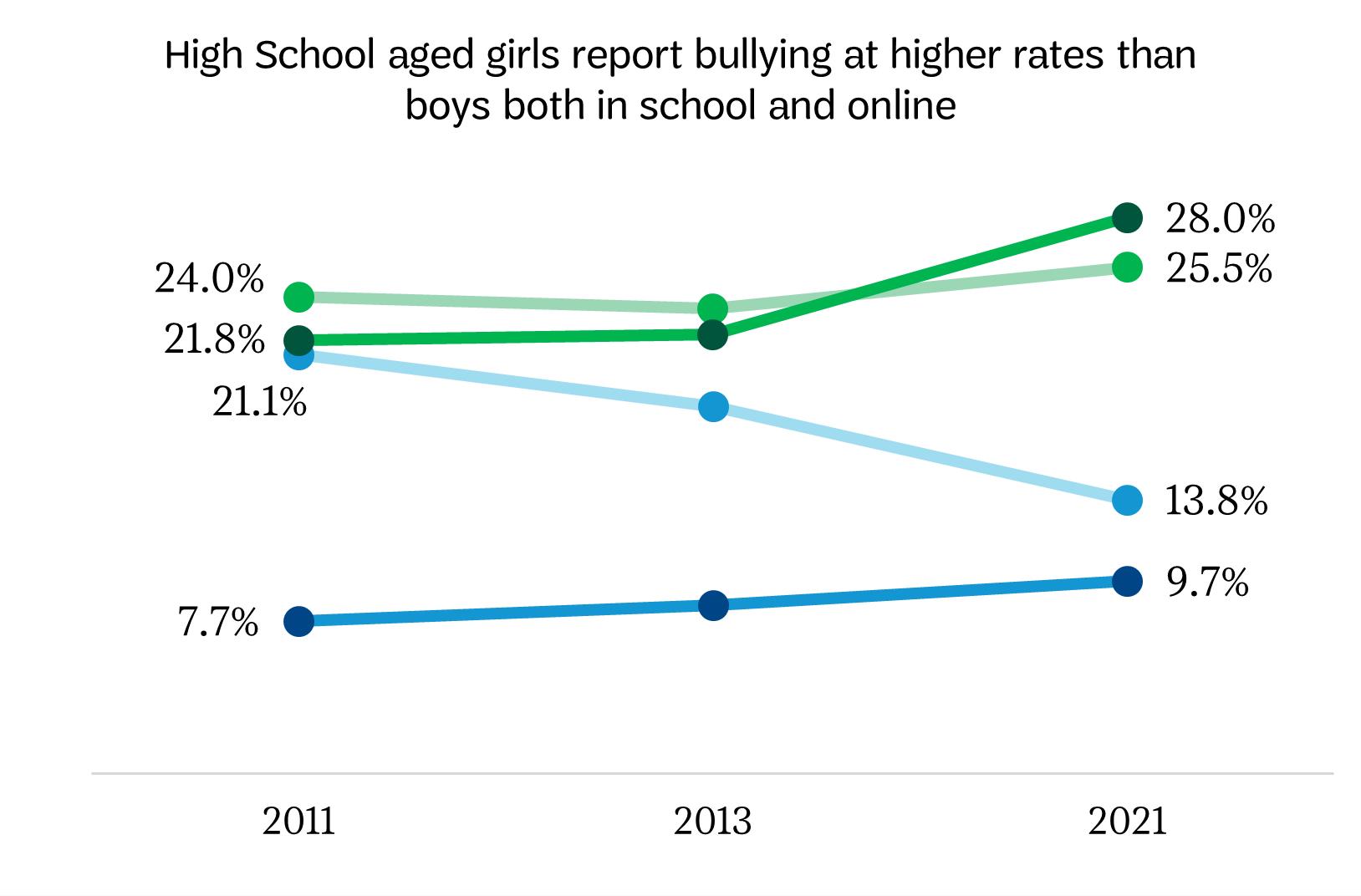




43%
Depending on the conditions, neighborhoods can provide an important place of connection for girls or can contribute to their anxiety and loneliness In Ohio, only 8% of girls lived in neighborhoods with no amenities such as parks, recreation centers, sidewalks, or libraries. Almost half of Ohio girls (43%) live near all four types of amenities. Most girls also lived in safe neighborhoods (71%), while 4% did not live in a safe neighborhood in 2022. of Ohio girls lived in neighborhoods that had all four amenities: parks, recreation centers, sidewalks, and libraries.
Ohio girls participated in clubs and activities such as dance, language lessons, or arts more than boys. The percentages of Ohio boys and girls ages 6-17 who participated in sports were similar over time, although participation for both boys and girls has decreased since 2016. This may, in part, be due to the impact of the pandemic that was still occurring in 2021-2022.

What is the best thing you did in Girl Scouts this year and what made it so special for you?
best thing that I did was make good friends.
school I was being picked on.

More than a quarter of K-12 students in Ohio did not attend school regularly in 2022-2023. Girls scored higher in English skills, while in math and science, younger boys did slightly better than girls, but more striking is that the gap closed by 8th grade, while proficiency fell in math for both boys and girls. Women go to college at higher rates than men and STEM degrees have increased among Ohio women, but nationally, women are underrepresented in STEM fields.
More than a quarter of K-12 students in Ohio did not attend school regularly in 2022-2023, with 27% of girls and 27% of boys facing chronic absenteeism, which is defined as a student missing 10% or more of school days for any reason, including excused and unexcused absences
1,611,956
students were enrolled in K-12 public and non-public education in Ohio in 2022-2023.
The importance of consistent school attendance cannot be overstated, as research has indicated poor school performance is associated with lower educational achievement, lack of social support, increased inflammation and reduced immune system functions, and a higher likelihood of smoking, drug use, and a sedentary lifestyle.
Starting in third grade, Ohio students take state achievement tests aligned with Ohio’s Learning Standards These tests aim to ensure students are meeting or exceeding grade level standards and expectations for subjects including English Language Arts (ELA), math, and science. A higher percentage of Ohio girls met proficiency standards in ELA than boys between 2020 and 2024.
By 8th grade the science and math proficiency gaps closed. Both boys’ and girls’ math and science proficiency scores showed improvement from 2021 to 2024.



Nationally, women are more likely to go to college, with men being underrepresented in post-secondary education dating back to the 1990s 12
Ohio’s public universities have a similar trend, with female enrollment outnumbering males at every type of higher education institution in fall 2023.
Ohio Undergraduate Enrollment Fall 2023
2015 2022 STEM and STEM-related careers of Ohio girls graduated high school in 2022-2023, compared to 87% of boys.
Ohioans aged 25 to 39 earned degrees in Science, Technology, Engineering, and Math (STEM) and STEM-related degrees at a slightly lower rate than the national average in 2015 and 2022 However, 25 to 39 year old women in Ohio who reported in 2022 that they had attained a STEM or STEMrelated bachelor’s degree had increased, from 36% to 39%. Still, national data show that women are underrepresented in STEM fields.13



When considering the intersection of girls’ social, emotional and physical health as well as academic success, three areas were identified where Ohio girls especially may need more support: Bullying, body image, and STEM interest and careers.
This section further explores these issues through national data and research but are not intended to be a comprehensive summary of all available data on the topics. This initial review may serve as a foundation for future stages of this project. Interestingly, building girls’ confidence in themselves and providing support from caring adults are strategies that can address all three of these issues.
Girls in Ohio consistently report higher rates of bullying and cyberbullying than boys (see page 14) This is of particular concern because many research studies have noted that being bullied has significant negative effects on physical health such as reduced sleep, increased stress hormones, and impaired brain functioning.
Bullying also contributes to anxiety, depression, and self-harming behavior (especially for girls). Being bullied is also linked to issues with substance abuse and violence as well as poor academic performance
Nationally, girls also report anticipating more ongoing bullying than boys. According to the 2022 School Crime Supplement to the National Crime Victimization Survey, females ages 12-18 who had been bullied were more likely to report that they anticipated the bullying to continue (46%) than males (36%).
Females who were bullied also reported experiencing more negative effects academically, socially, mentally, and physically than males
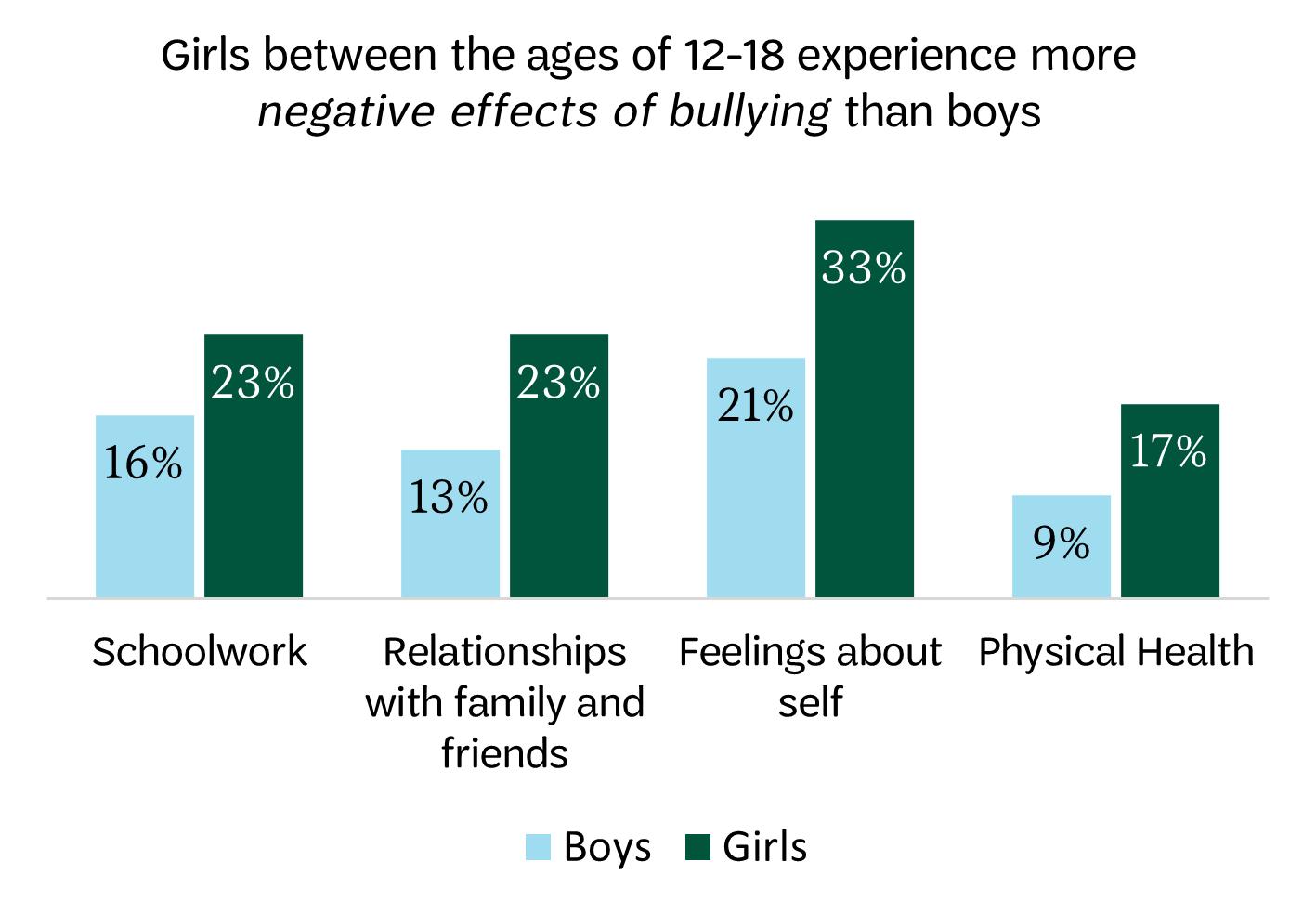

Females were also more likely than males to perceive that the bullying was related to their gender, sexual orientation, and appearance.
In a separate study, Black girls reported experiencing higher levels of harassment at school due to their race, gender, and appearance.
Cyberbullying is especially a concern because of its prevalence and potential for devastating effects
Depression, anxiety, and suicidal ideation rates are higher for victims of cyberbullying than for people who experience other types of bullying. Pew Research Center conducted a national survey in 2022 that found that 43% of boys and 49% of girls ages 13 to 17 reported experiencing cyber-bullying

One reason why girls, especially older teens, may experience higher rates of cyber-bullying is that they are more frequent users of social media.
Students who use the internet for three or more hours per day are more likely to be perpetrators, victims, and perpetrators–victims of cyberbullying. The Pew Research Center study - Teens, Social Media and Technology 2023 - found that 46% of teens say they use the internet almost constantly. High school girls reported experiencing the most overall cyberbullying and were also more likely to be victims of each type of cyberbullying other than physical threats 20
Receiving
Spreading
Constantly being asked where they are, what they’re doing, or who they’re with by someone other than their parent
Having explicit images of them shared without their consent Physical threats

Boys 13 - 14
Students who witness someone else being cyberbullied may also be at risk for mental health issues. Witnesses may not know how to respond when they see others being bullied, resulting in feeling more anxious and helpless They may also take the wrong kind of action, which could negatively affect their mental health and even result in suicidal ideation
The federal website stopbullying.gov provides resources for kids, teens, and adults to prevent and address bullying. Some strategies include:
Help girls establish supportive connections with caring adults
Monitor use of social media and teach digital literacy
Encourage schools and other organizations to provide effective anti-bullying education
Encourage provision of mental health counseling at schools
Ohio law requires schools and districts to adopt policies prohibiting harassment, intimidation, and bullying The Ohio Department of Education and Workforce website provides schools and families with a number of resources to address bullying.
A healthy body image refers to when people feel comfortable in their own body and are satisfied with their appearance and selfworth. People with an unhealthy body image are more prone to developing serious mental health conditions, such as eating disorders and depression.
Research indicates that girls are more likely to have lower body appreciation than boys, with a gender difference in body appreciation, but people of all genders can suffer from negative body image. Unfortunately, many girls start to worry about their weight from the ages of 6 to 10, and by age 14, 60-70% of girls start to try to lose weight and may become victims of eating disorders
Several factors may contribute to a negative body image, including pressure from relatives and peers, exposure to unrealistic body expectations from traditional and social media, and engagement in social appearance comparisons.
Ohio Safer Schools Tipline
Students, staff, and parents can call or text the Ohio Safer Schools Tipline at 844-SaferOH 24 hours per day
57% makes them want to change how they look
66% their body makes them feel less confident
A national survey by Ruling Our Experiences found that most girls experience negative messaging: said social media said how they feel said they are under
88% pressure to be pretty

Engaging in rigorous physical activities, especially in sports, can often help adolescents realize their self-worth, promote a better mental representation of what they think of themselves, and promote body satisfaction. Additionally, having a positive body image can influence adolescent girls to participate in more physical activities However, the amount of physical activity tends to decline among young and adolescent girls in the United States, which is also noted in Ohio (see page 10)
One strategy that was found to be helpful in encouraging more physical activity is providing behavioral skills mentoring. Appalachian teens in southern Ohio were found to improve in weight loss, body mass index, and body fat after participating in a mentoring program.
Improving digital literacy is another strategy for helping children and adolescents better identify negative body image messaging In addition, cultivating teenagers’ ability to generate selfcompassion and to receive compassion from others can facilitate a healthy body image among young people, especially girls, and reduce negative behaviors related to eating and body image.
Resources for Eating Disorders
National Alliance for Eating Disorders
Helpline: 1-866-662-1235. Resources are available Monday through Friday, 9 AM - 7 PM ET
Science, technology, engineering and mathematics (STEM) careers have many benefits, including personal development (i.e., increase critical thinking skills, creativity, logic, innovation) and economic benefits (i.e., more competitive salaries than non-STEM careers)
However, research shows that not enough students graduate with STEM degrees and go into STEM fields to meet societal needs. STEM jobs are also anticipated to grow in Ohio, and the state is concerned about finding enough workers to fill them
Although the number of women in STEM careers has increased in recent years, they continue to be underrepresented nationally and in Ohio (see page 17) Women are also more likely to pursue STEM careers in math, biology and the physical sciences rather than engineering, which is the field that makes up 80% of the STEM workforce. The reason for this gender divide in professions is not fully understood but may be due to a variety of factors, including gender stereotypes and ideas of what is considered to be a “male” or “female” field.
Through the many provided opportunities involving friendship, learning, skill-building, STEM and entrepreneurship, Girl Scouts has helped me to become more courageous and confident in all aspects of life.
- Brinley A , Girl Scout


The Society of Women Engineers created this chart with Department of Labor data to note the number of women in biological sciences since 1980, exceeds the number of men, while only about 17% of architects and engineers are women. Unfortunately, women in STEM fields continue to face inequity in pay, with researchers estimating women are entering the STEM work force earning $61,000 on average annually while men on average earn an additional $4,000 a year While the reasons for the gap in wages is unclear, one 2020 study found there may be cultural gender beliefs that contribute to feelings of self-doubt and a lack of confidence in women. These doubts in self-efficacy may impact performance, leading to professional self-sorting, employer rejection, and a lack of feeling of belonging, which may impact salary.
Research suggests early STEM education is crucial because student attitudes about science are largely solidified at an early age and often decline steeply in adolescence. Unfortunately, girls’ interest in STEM tends to fade by 11 years old and continues to decline through the remainder of their education.
The study did identify some successful strategies for increasing female participation in STEM initiatives, stating “it is time to stop seeing girls as the problem and accept that it might be society’s attitudes that often holds them back.”
Build girls’ STEM identity and ability to resist existing stereotypes
Increase awareness of STEM careers and opportunities
Intentionally showcase women’s participation in STEM careers
Work to shift societal perceptions of STEM careers through changes to school STEM curriculum and pedagogy to acknowledge gender inequities

Additional suggestions for increasing girls’ early interest in STEM include girls-only STEM camps, incorporating creative activities in STEM education, and providing professional development to help educators learn to support girls’ self-image as someone who b l g i STEM
Overall, the key to increasing girls’ interest in STEM careers is to provide early and consistent encouragement and education that counteracts negative stereotypes.
75%
of Girl Scouts in middle and high school activities were interested in taking STEM compared to only 50% among those who did not do STEM activities.
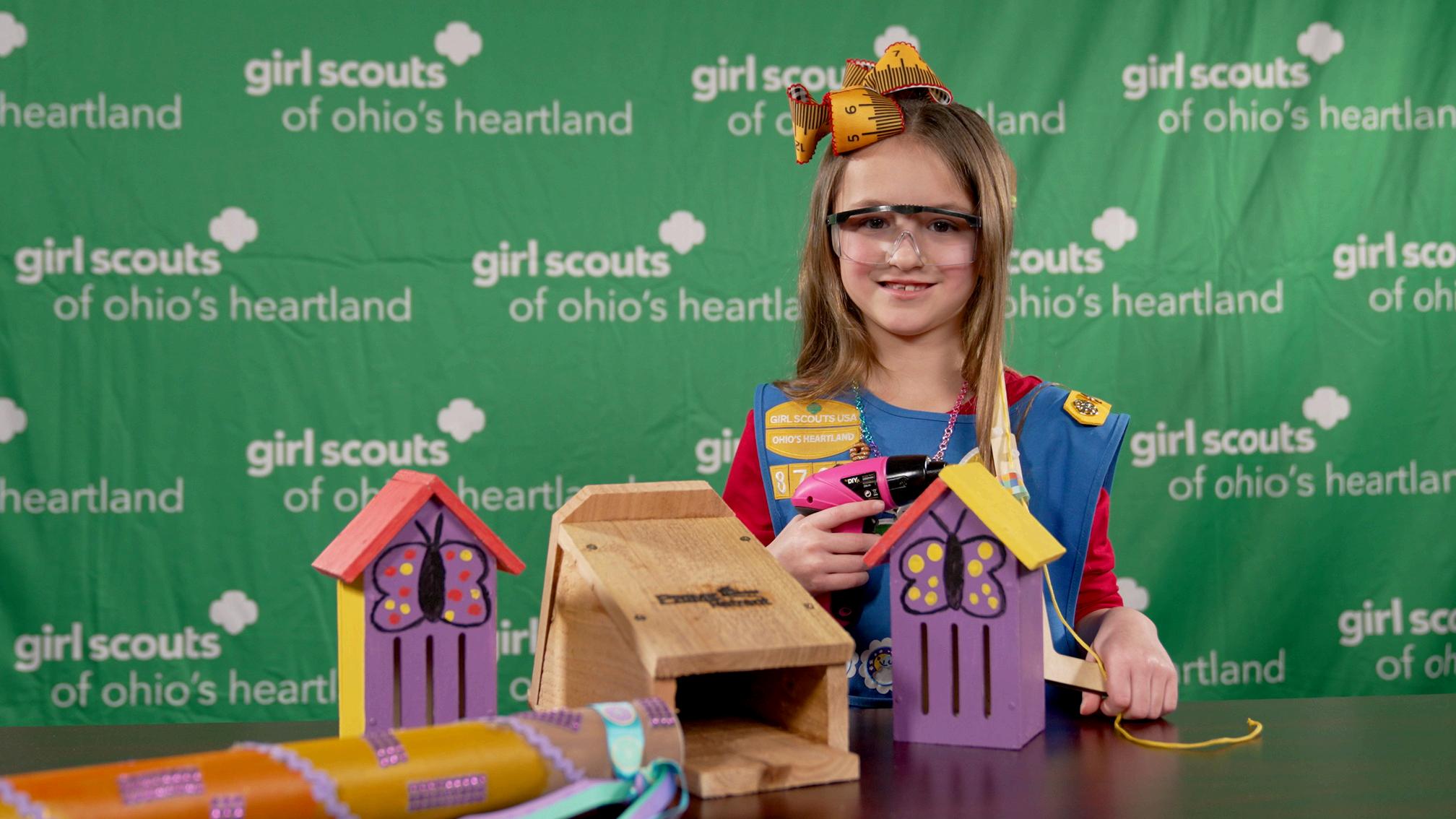
63% of Girl Scouts in middle and high school, who did multiple STEM activities aspire to a career in STEM, compared to 43% among those who did not do STEM activities.
You can make choices now that increase your own well-being, and help you create an interesting and meaningful life, community of friends and opportunities for the future. Join After-School Programs
Be An Upstander Develop Your Strengths
You have a unique perspective on the challenges that you and your friends face. Stand up for your beliefs – and for a community where you and other girls feel safe and are encouraged to “speak up and team up” for change Commit to safe online practices and to developing healthy relationship skills with your friends.
Be curious and seek opportunities to learn about new interests and careers that build on your strengths Develop new abilities by being willing to try “hard things” that matter to you and stick with it Find friends and organizations that encourage you to stretch yourself.
Seek programs that give you the opportunity to stay active and explore different interests so that you can discover your unique strengths and new potential career opportunities. Make adults aware of bullying and violence so that they can intervene. If adults don’t know, they can’t help.

Seek Mentors
Seek out caring adult mentors to help you navigate the unique challenges you face. There are many adults in your school and community who want to support you Ask for help from caring adults in your school, faith or after school community to help navigate challenges.

Thank you, Girl Scouts, for believing in us! Thank you, Girl Scouts, for taking big steps! Thank you, Girl Scouts, for a brighter future! Thank you, Girl Scouts, for the POWER TO BECOME!

I want to make the world a better place. Girl Scouts teaches you how to be respectful to the Earth and all the people around us.
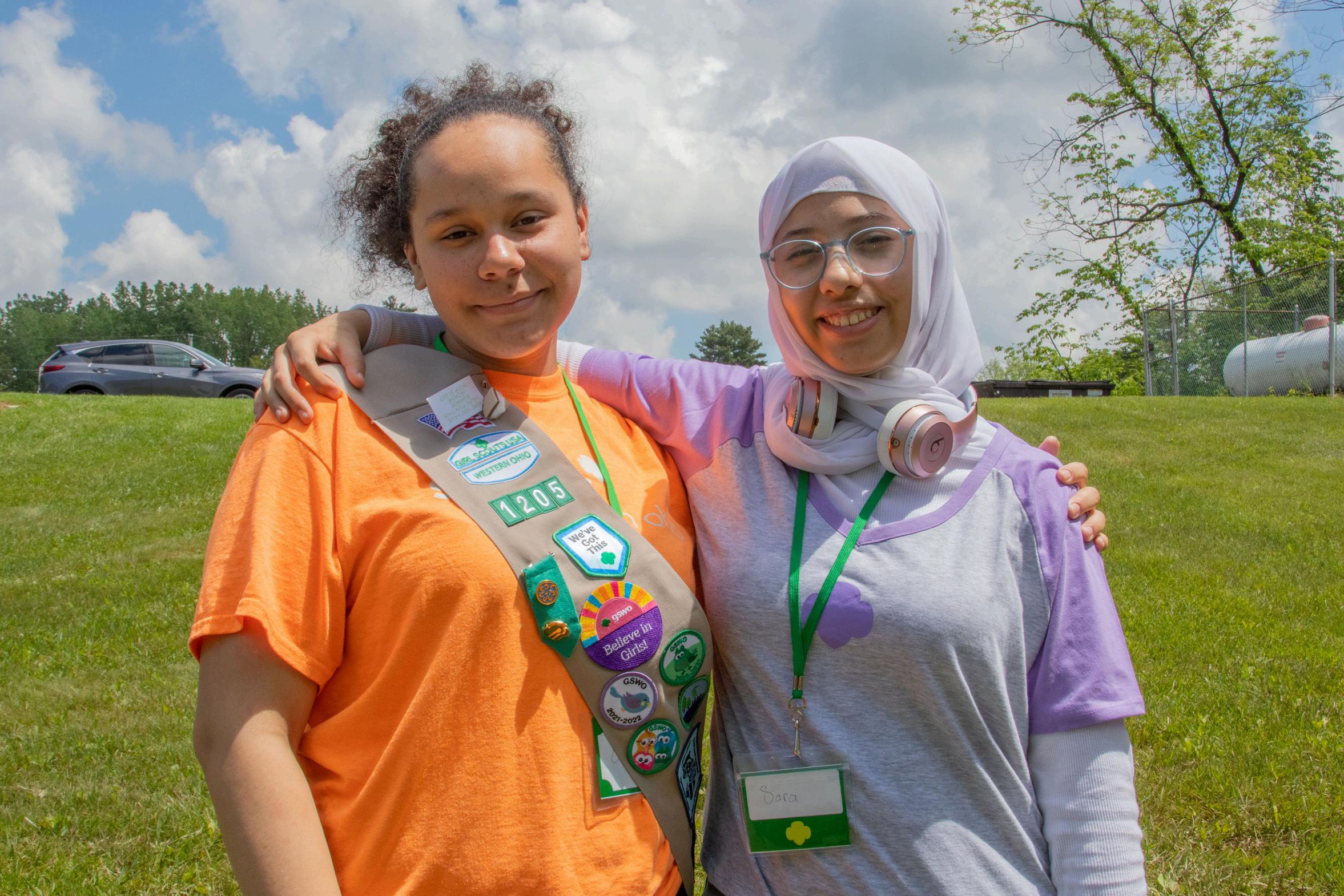

Girl Scouts has allowed me to build resilience and selfassurance. I also learned vital collaboration, communication, and problem-solving skills that have allowed me to grow as a leader.
To me, Girl Scouts means opening up my circle and getting to meet new people and becoming more comfortable with who I am and what I can do.

Thank you to the Girl Coalition of Indiana for their incredible work on the Indiana Girl Report, highlighting the challenges and opportunities facing girls in their state. Together we can build a future where girls can thrive.